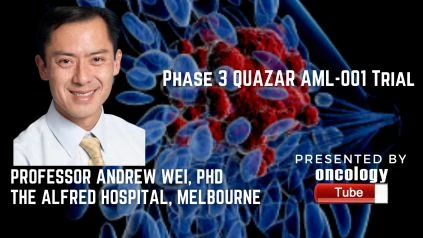Professor Andrew Wei is a haematologist at the Alfred Hospital and a Victorian Cancer Agency Research Fellow. Andrew has dual appointments at the Alfred Hospital and Monash University, where he does clinical and translational AML research. In this video Professor Wei discusses the Long-Term Overall Survival (OS) with Oral Azacitidine (Oral-AZA) in Patients with Acute Myeloid Leukemia (AML) in First Remission after Intensive Chemotherapy (IC): Updated Results from the Phase 3 QUAZAR AML-001 Trial.
Link to Abstract-
https://ash.confex.com/ash/2021/webprogram/Paper147501.html
BACKGROUND: While many older patients (pts) with AML achieve complete remission (CR) with IC therapy, 80% will recur, and overall survival (OS) is dismal. Oral-AZA (CC-486), a hypomethylating drug, was evaluated in pts with AML in remission following IC who were not eligible for stem cell transplant in the randomized, placebo-controlled, phase 3 QUAZAR AML-001 trial. Oral-AZA was associated with significantly longer OS vs. PBO at the primary data cutoff in July 2019: 24.7 vs. 14.8 months (mo), respectively (P 0.001) (Wei, 2020), while the tails of the Kaplan-Meier OS curves for Oral-AZA and PBO began to converge at subsequent time-points (after 48 mo). At the primary cutoff, more than a quarter of all randomized patients (125/472 [26.5 percent]) were still receiving Tx with Oral-AZA (n = 45) or PBO (n = 26) or were alive in survival follow-up (n = 26 and n = 28). Following trial unblinding, patients were monitored for OS (but not relapse-free survival). After more than a year of extra follow-up, we examined longer-term OS for pts in QUAZAR AML-001 as of September 2020.
METHODS: The study design and pt eligibility have been described in detail. In brief, eligible patients were 55 years old, had newly diagnosed AML, intermediate- or poor-risk cytogenetics at AML diagnosis (Dx), and ECOG PS 3 before screening, and had achieved initial CR or CRi following IC (induction consolidation). Pts were randomized 1:1 to Oral-AZA 300 mg or PBO QD for 14 days/28-day Tx cycle within 4 months of CR/CRi. Pts in the Oral-AZA arm might receive Tx in an extension phase if they continued to benefit after trial unblinding in July 2019; pts in the PBO arm had Tx terminated and were followed for OS. From the moment of randomization until death, withdrawal of consent, or loss to follow-up, Kaplan-Meier estimated OS was determined and compared between Tx arms using a log-rank test. We examined baseline (BL) demographic and illness characteristics of pts who were alive (on-Tx and/or in survival follow-up) for 3 years from randomization (“Long-term [LT] Survivors”) vs. those of pts who died or were censored before 3 years to see if pt-related factors influenced OS.
In all, 472 patients were assigned to one of two groups: Oral-AZA (n = 238) or PBO (n = 234). 91 percent of patients had de novo AML, and 86 percent had intermediate-risk cytogenetics, with a median age of 68 years (range 55–86). After trial unblinding, 39 points (16%) in the Oral-AZA group progressed to the extension phase. Overall, 31.4 percent and 15.5 percent of patients received Oral-AZA or PBO treatment for more than 24 months, respectively.
At the updated follow-up in September 2020, 54 patients (23%) in the Oral-AZA arm were still alive in survival follow-up, with 31 patients (13%) continuing receiving Oral-AZA in the extension phase; 165 patients (69%) had died, and 19 patients (8%) had withdrawn consent or were lost to follow-up. In the PBO arm, 35 participants (15%) were still living, 176 (75%) had died, and 23 (10%) had withdrawn consent or had been lost to follow-up.
The median OS in each arm remained unchanged from the primary cutoff date at 51.7 months: 24.7 vs. 14.8 months for Oral-AZA and PBO, respectively (P = 0.0008); however, the KM OS curves for Oral-AZA and PBO showed greater separation with additional follow-up, and the two curves did not touch or cross at any time (Figure). The Oral-AZA and PBO arms had KM-estimated 3-year survival rates of 37.4 percent and 27.9 percent, respectively (+9.5 percent [95 percent CI 0.9 percent, 18.1 percent]).
The LT Survivors cohort included 140 participants (29.7%) in the Oral-AZA (n = 83) and PBO (n = 57) arms who had been alive for at least three years. LT Survivors were more likely to have intermediate-risk cytogenetics (95 percent vs. 82 percent) and an NPM1 mutation (45 percent vs. 9 percent) at AML Dx, and less likely to have MRD+ at BL than pts who died or were censored before 3 years (33 percent vs. 52 percent ). On-study, 71 percent (34/48) of pts with post-IC MRD+ at BL in the LT Survivors cohort developed MRD negative, compared to 15 percent (26/172) in the 3-year cohort (P 0.0001).
Conclusions: With more than a year of additional survival follow-up in QUAZAR AML-001, median OS in both Tx arms remained unchanged, but the tails of the Oral-AZA and PBO OS curves showed greater separation at later time-points than in the primary analysis (which may have been confounded by extensive censoring), indicating a sustained, long-term OS benefit with Oral-AZA. In QUAZAR AML-001, intermediate-risk cytogenetics and NPM1 mutations at AML Dx, as well as the absence of detectable MRD post-IC, were linked to long-term survival.

